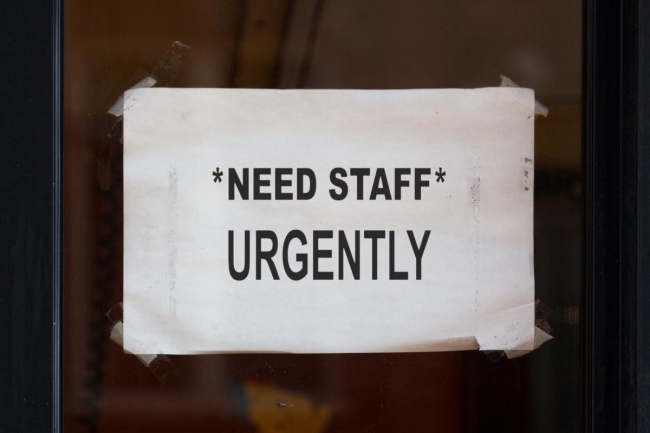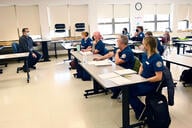You have /5 articles left.
Sign up for a free account or log in.

Community colleges lost a significant portion of their workforce and have yet to recover.
Gwengoat/iStock/Getty Images Plus
Community colleges across the country are struggling to recruit and hire new people after losing faculty and staff members in droves during the pandemic.
The institutions lost 13 percent of their employees nationally from January 2020 to April 2022, according to an estimate from EAB, a higher education consulting firm. A recent data analysis from EAB shows that four-year colleges mostly recouped their losses after also experiencing sharp declines in staff, unlike community colleges, which have lagged in their recovery.
These data points are part of an ongoing research effort to study attrition at community colleges and were shared late last month in a webinar hosted by EAB and the League for Innovation in the Community College, an organization dedicated to helping community colleges innovate to improve student success outcomes.
Tara Zirkel, director of strategic research at EAB, who led the webinar, said she consistently hears from campus leaders that their staffs are now too small to carry out necessary college functions after employees left for higher-paying roles at four-year universities or in private industry, sought out jobs with remote options or more flexible work schedules, or simply quit due to burnout.
She noted that the concerns about staffing shortages are a reversal from earlier in the pandemic, when some community college leaders were urging people to retire early or take furloughs to cut costs as enrollments plummeted.
“We moved from this point of feeling like we have too much staff to feeling like we don’t have enough staff,” she said.
College leaders report staffing losses at all levels, including IT workers, student success professionals, dining hall workers and executive leaders, she said. The number of community college faculty members also dropped 8.6 percent, from 308,567 professors in fall 2019 to 281,932 in fall 2020, according to a report from the American Association of University Professors. Faculty members in career and technical education fields have been particularly difficult to retain as private sector employers offer higher pay to fill their own workforce gaps.
The result is stalled projects, a near constant cycle of hiring attempts and onboarding processes for new employees, and heavy workloads on those who remain.
Joe Garcia, chancellor of the Colorado Community College System, said multiple colleges in the system lost at least a fifth of their staffs during the pandemic. The turnover rate at Pikes Peak State College, for example, nearly doubled between fiscal years 2021 and 2022, from 11 percent to 21 percent. Community College of Denver lost more than a third of its employees, 39 percent, during that time.
The loss of IT workers, and an inability to find new ones, has been a particular strain on the system.
“Certainly as we’ve tried to move more of our business operations and more of our instruction to do things remotely, we’ve become much more reliant on IT professionals,” Garcia said. “And yet they’re some of the hardest to retain and to recruit. We’re looking to hire people with less experience in order to get them in the door.”
Christina Cecil, the system’s chief human resources officer, said some out-of-state job candidates wanted to remain where they are and work remotely. Some employees have also asked if they can move out of Colorado and continue working for the system remotely because of the high cost of living in the state. But the system doesn’t have enough administrative staff to navigate the complexities of managing a multistate workforce and can’t offer the flexibility some employees want. Meanwhile, the loss of more seasoned employees with valuable institutional knowledge has been especially hard. “We have folks who have decided to retire or move on that have been with us for many, many years,” Cecil said. “And that’s a big loss to an organization when you have that knowledge walk out the door—and sometimes with less planning than you would have anticipated.”
Heidi Leming, vice chancellor for student success at the Tennessee Board of Regents, one of two public higher ed systems in the state, said burnout from the stresses of the pandemic and a desire for flexible work led to a rash of departures and early retirements at the state’s 13 community colleges, including academic counselors and others who were the most involved in fielding student questions and concerns during the pandemic. She also noted that a growing lack of financial aid officers at the colleges risks slowing down the processing of student financial aid paperwork.
Staff members are working additional hours and taking on more responsibilities to ensure students don’t feel the effects of the labor shortages, but the heavier workloads are “taxing” for them, Leming said.
“I am hearing much more from our staff about concerns related to their own mental health,” she said. “I think we’ve always been attuned to student mental health, but more and more I’m hearing on campuses [about] what can they do for employees to help them manage the stress.”
Fewer Hands to Help Students
The labor shortages come with consequences for students despite campus leaders and staff members’ best efforts to insulate them.
Rufus Glasper, president and CEO of the League for Innovation in the Community College, said the loss of adjunct faculty members in particular limits the course offerings available to students.
“You don’t have as many options to move through your programs as quickly as you would under the normal circumstances,” he explained during the webinar.
He noted that some community colleges are partnering to provide courses so that students can access a wider variety of classes across various campuses.
Students also might struggle to get some of the supports and services they need in a timely manner because of the staff shortages. EAB researchers secretly posed as prospective students using colleges’ virtual application, enrollment and onboarding processes and found that tasks that might ordinarily take a few days to complete took a lot longer due in part to insufficient staffing. It took researchers a full three weeks to enroll on average.
Zirkel said while employee shortages weren’t solely to blame, one of the challenges researchers faced was difficulty contacting staff members and getting guidance on programs.
“We have less hands to service students who are already having a difficult time enrolling,” she said.
Zirkel added that students are increasingly coming to college with mental health problems, a lack of reliable food and housing, and learning losses from the pandemic, which makes having adequate staff to support them all the more critical.
“It’s going to require a really specific and delicate set of services and set of people to be able triage those students and help them navigate through enrollment,” she said. “When you have sort of this increased need for services and decrease in staff, there’s a gap that’s going to exist there that’s going to be really, really hard … unless we get a handle on this Great Resignation.”
The webinar offered a number of recommendations to community colleges struggling with attrition, including strategically using technology to lighten workloads for stretched-thin employees and making work schedules more flexible. Some institutions are already making these efforts. For example, Cleveland College stopped holding classes on Fridays and allows employees to work from home that day, and multiple community colleges, such as Community College of Philadelphia and Community College of Alleghany County, instituted a four-day workweek during the summer.
Zirkel also suggested community colleges focus job ads on perks candidates care about, such as remote work policies, opportunities for career advancement, mental health benefits and subsidized childcare.
Garcia, of the Colorado Community College System, said he plans to put more tuition and state dollars toward higher salaries to recruit and retain workers.
“We’re trying to offer more competitive wages,” he said. “We’re trying, wherever possible, to allow for more flexible work arrangements … And we’re also trying to emphasize our mission, that there’s a good reason to work here beside the money, and it is the impact we make in our communities.”
Zirkel believes attrition and recruitment problems at community colleges aren’t going away anytime soon, so it’s important that campus leaders start to address them. She pointed out that, given demographic shifts and the decline in the number of working-age adults, the American workforce is expected to shrink by six million people by 2028. Community colleges will be forced to vie for an increasingly limited pool of candidates, which means continuing to go head to head with private industries and universities.
“This is not just a right-now problem,” she said. “This is an into-the-future problem.”





